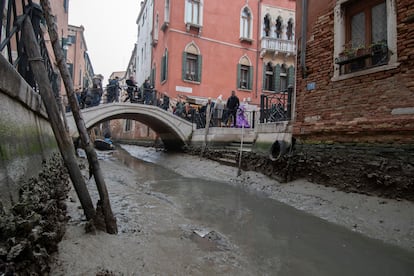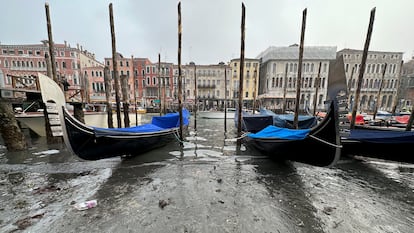Venice’s canals are emptying, and so are its streets
A combination of unusual atmospheric phenomena, coupled with a severe drought in northern Italy, has left the flood-prone tourist favorite high and dry
When the sirens sound at this time of the year, first-time visitors feel their hair stand on end. The mechanical howls from a system of alarms across the city indicate that the acqua alta is imminent and that the narrow streets of Venice will be flooded in a few seconds. These alarms are usually accompanied by the metallic rumbling of locals clambering onto raised platforms until the tide recedes again. Venice has been protecting itself from this phenomenon for a lifetime, and in 2003 it began construction on massive infrastructure project with a biblical name (MOSE) to stop an aquatic onslaught that climate change has served to accentuate. MOSE is up and running, and it works. But no one anticipated that this year, in a place besieged by water, Venice would be praying for a chance to use it.
Many of Venice’s canals have dried up in recent days, a relatively common occurrence but one that has not been this pronounced since 2008. The foundations of the city’s palaces were visible through the mud on Wednesday morning. The gondolas can barely navigate in the canals around San Polo and La Madonetta. Tourists gaze in wonder – as they do with everything that happens in Venice – at the spectacle of the world’s largest tourist industry shipwrecked on a pile of mud. “If it’s not one thing, it’s another. You see, we don’t get ahead here by taking risks. Of course, we work less during these periods and many of the private boats can’t move,” says Andrea, a gondolier leaning against the Ponte de Ca’Bernardo, one of the 436 bridges that connect the lagoon city’s 121 islands. “Want to go for a ride?” he ventures, pointing to a sign that sets the half-hour boat trip at €80 ($85).
The peak of the phenomenon occurred at 6pm on Wednesday, when the mass of tourists who had arrived for the Carnival celebrations left the city, dragging their suitcases behind them and emptying its streets. The water level in the canals has been below the average of 50 to 79 centimeters and far below the recent record of 2019, when one of the worst acqua altas in history caused a rise to 187 centimeters. Timing is key. Around 70% of low tide phenomena occur during January and February. The current unusual Venetian panorama, however, has been caused by a combination of meteorological factors. In addition, the drought suffocating northern Italy, these past few days have coincided with high atmospheric pressure, various sea currents affecting the lagoon and a full moon. According to the city’s tide monitoring and forecast center, the exceptional nature of the phenomenon is not so much in the sub-zero tide measurements reached by the lagoon, which fell to -60 cm in recent days, as in its duration: such levels have not been witnessed for 16 years.

Images of Venice’s canals are reminiscent of the drought that has been gripping northern Italy: last summer, the basin of the ever-flowing Po river was almost completely dried out. The Po, Italy’s longest river, which runs from the Alps in the northwest to the Adriatic, is carrying 61% less water than the average for this time of year. There are many more symptoms of the worst drought in the last 70 years. Water levels in Lake Garda in northern Italy have also fallen to historic lows, making it possible to reach the small island of San Biagio on foot. But these are parallel phenomena. “Drought is a climatic phenomenon, not meteorological, like tides. But the peaks are linked to temperature,” says Gigi Lazzari of the Legambiente environmental organization.
Alvise Papa, the head of Venice’s tide monitoring and forecast center, also rules out a direct link between the emptying of the canals and the wider drought. But the root cause, he points out, is the same. “A stationary anticyclone in place since the end of January is causing high pressure. This phenomenon prevents [climatic] disturbances from reaching northern Italy, and, therefore, it doesn’t rain. But the high pressure also doesn’t allow the high tide to develop normally,” he explains. “An anticyclone is a specific circulation of the atmosphere and in the Adriatic, it turns into northerly winds, which cause strange currents in the sea. The average level of the Adriatic this February is plus-2 cm, while last year it was plus-21 cm. In addition, this high pressure does not allow the tide to develop. It normally enters the Strait of Otranto channel, moves up the Croatian coast and then down the coast of Italy. With northerly winds, that flow is partly diminished, so the average level of the Adriatic is lowered.” Papa also points to astronomical gravitational phenomenon as another cause of this unusual draining.
The problem in Venice is that the canals, in the absence of other means of mobility, make up its traffic network. But the city is used to facing all manner of threats and local authorities have played down the importance of the low water levels. “There is no need for special measures. Those who operate the boats know they will not be able to navigate through some canals. It is a matter the public transport company manages.”
Sign up for our weekly newsletter to get more English-language news coverage from EL PAÍS USA Edition
Tu suscripción se está usando en otro dispositivo
¿Quieres añadir otro usuario a tu suscripción?
Si continúas leyendo en este dispositivo, no se podrá leer en el otro.
FlechaTu suscripción se está usando en otro dispositivo y solo puedes acceder a EL PAÍS desde un dispositivo a la vez.
Si quieres compartir tu cuenta, cambia tu suscripción a la modalidad Premium, así podrás añadir otro usuario. Cada uno accederá con su propia cuenta de email, lo que os permitirá personalizar vuestra experiencia en EL PAÍS.
¿Tienes una suscripción de empresa? Accede aquí para contratar más cuentas.
En el caso de no saber quién está usando tu cuenta, te recomendamos cambiar tu contraseña aquí.
Si decides continuar compartiendo tu cuenta, este mensaje se mostrará en tu dispositivo y en el de la otra persona que está usando tu cuenta de forma indefinida, afectando a tu experiencia de lectura. Puedes consultar aquí los términos y condiciones de la suscripción digital.
More information
Últimas noticias
Trump claims peace in Ukraine is near, but Moscow suggests otherwise
A survivor’s account of the Interoceanic Train accident: ‘We were scared because of the speed on the curve’
The Interoceanic Train, the Mexican alternative to the Panama Canal
What is known about the Interoceanic Train derailment in Oaxaca
Most viewed
- Oona Chaplin: ‘I told James Cameron that I was living in a treehouse and starting a permaculture project with a friend’
- Reinhard Genzel, Nobel laureate in physics: ‘One-minute videos will never give you the truth’
- Why the price of coffee has skyrocketed: from Brazilian plantations to specialty coffee houses
- Pablo Escobar’s hippos: A serious environmental problem, 40 years on
- Chevy Chase, the beloved comedian who was a monster off camera: ‘Not everyone hated him, just the people who’ve worked with him’












































